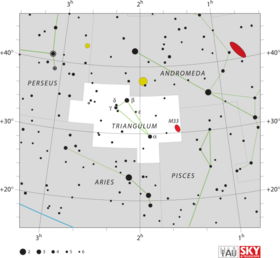Astronomy:Iota Trianguli
From HandWiki
Short description: Quadruple star system in the constellation Triangulum
| Observation data {{#ifeq:J2000.0|J2000.0 (ICRS)|Epoch J2000.0 Equinox J2000.0 (ICRS)| [[History:Epoch|Epoch J2000.0]] [[Astronomy:Equinox (celestial coordinates)|Equinox J2000.0}} | |
|---|---|
| Constellation | Triangulum |
| A | |
| Right ascension | 02h 12m 22.2797s[1] |
| Declination | +30° 18′ 11.053″[1] |
| Apparent magnitude (V) | 5.32[2] |
| B | |
| Right ascension | 02h 12m 22.5637s[3] |
| Declination | +30° 18′ 12.342″[3] |
| Apparent magnitude (V) | 6.83[2] |
| Characteristics | |
| A | |
| Spectral type | G0 III + G5 III[4] |
| B−V color index | +0.856[5] |
| Variable type | ellipsoidal + RS CVn[6] |
| B | |
| Spectral type | F5V + ?[2] |
| B−V color index | +0.515[5] |
| Astrometry | |
| A | |
| Proper motion (μ) | RA: −64.350[1] mas/yr Dec.: −59.503[1] mas/yr |
| Parallax (π) | 11.3011 ± 0.1024[1] mas |
| Distance | 289 ± 3 ly (88.5 ± 0.8 pc) |
| B | |
| Proper motion (μ) | RA: −64.414[3] mas/yr Dec.: −49.913[3] mas/yr |
| Parallax (π) | 12.7375 ± 0.5496[3] mas |
| Distance | 260 ± 10 ly (79 ± 3 pc) |
| Absolute magnitude (MV) | +0.20[7] |
| Orbit[8] | |
| Primary | Aa |
| Companion | Ab |
| Period (P) | 14.73018 days |
| Semi-major axis (a) | 0.002[9]″ |
| Eccentricity (e) | 0.0035 |
| Inclination (i) | 55 – 58[9]° |
| Semi-amplitude (K1) (primary) | 54.84 km/s |
| Semi-amplitude (K2) (secondary) | 56.39 km/s |
| Orbit[10] | |
| Primary | Ba |
| Companion | Bb |
| Period (P) | 2.2365 days |
| Eccentricity (e) | 0 |
| Semi-amplitude (K1) (primary) | 95.4 km/s |
| Semi-amplitude (K2) (secondary) | 101.0 km/s |
| Details | |
| Aa | |
| Mass | 2.50[9] M☉ |
| Radius | 4.0[8] R☉ |
| Luminosity | 61.7[8] L☉ |
| Temperature | 4,932[8] K |
| Rotational velocity (v sin i) | 32.9[8] km/s |
| Ab | |
| Mass | 2.43[9] M☉ |
| Radius | 1.5[8] R☉ |
| Luminosity | 10.0[8] L☉ |
| Temperature | 6,486[8] K |
| Rotational velocity (v sin i) | 3.0[8] km/s |
| Ba | |
| Mass | 1.58[9] M☉ |
| Bb | |
| Mass | 1.56[9] M☉ |
| Other designations | |
| Database references | |
| SIMBAD | data |
Iota Trianguli, Latinized from ι Trianguli, is a quadruple[2] star system in constellation of Triangulum. The pair have a combined apparent magnitude of 4.95[12] and are approximately 290 light years from Earth.
Both components of ι Trianguli are spectroscopic binaries and the brighter pair is variable. It has been given the variable star designation TZ Trianguli. The variations are due to the ellipsoidal shape of the stars as they rotate, and also it is classified as an RS Canum Venaticorum variable.[14]
Together with 10 Trianguli and 12 Trianguli, it forms part of the obsolete Triangulum Minus.
References
- ↑ 1.0 1.1 1.2 1.3 1.4 Vallenari, A. et al. (2022). "Gaia Data Release 3. Summary of the content and survey properties". Astronomy & Astrophysics. doi:10.1051/0004-6361/202243940 Gaia DR3 record for this source at VizieR.
- ↑ 2.0 2.1 2.2 2.3 Eggleton, P. P.; Tokovinin, A. A. (September 2008), "A catalogue of multiplicity among bright stellar systems", Monthly Notices of the Royal Astronomical Society 389 (2): 869–879, doi:10.1111/j.1365-2966.2008.13596.x, Bibcode: 2008MNRAS.389..869E.
- ↑ 3.0 3.1 3.2 3.3 3.4 Vallenari, A. et al. (2022). "Gaia Data Release 3. Summary of the content and survey properties". Astronomy & Astrophysics. doi:10.1051/0004-6361/202243940 Gaia DR3 record for this source at VizieR.
- ↑ Harlan, E. A. (September 1969), "MK classifications for F- and G-type stars. I", Astronomical Journal 74: 916–919, doi:10.1086/110881, Bibcode: 1969AJ.....74..916H.
- ↑ 5.0 5.1 Myers, J. R.; Sande, C. B.; Miller, A. C.; Warren, W. H.; Tracewell, D. A. (2015), "VizieR Online Data Catalog: SKY2000 Master Catalog, Version 5 (Myers+ 2006)", Vizier Online Data Catalog, Bibcode: 2015yCat.5145....0M.
- ↑ Samus, N. N. et al. (2017), "General Catalogue of Variable Stars", Astronomy Reports, 5.1 61 (1): 80–88, doi:10.1134/S1063772917010085, Bibcode: 2017ARep...61...80S.
- ↑ Anderson, E.; Francis, Ch. (2012), "XHIP: An extended hipparcos compilation", Astronomy Letters 38 (5): 331, doi:10.1134/S1063773712050015, Bibcode: 2012AstL...38..331A.
- ↑ 8.0 8.1 8.2 8.3 8.4 8.5 8.6 8.7 8.8 Massarotti, Alessandro et al. (January 2008), "Rotational and Radial Velocities for a Sample of 761 HIPPARCOS Giants and the Role of Binarity", The Astronomical Journal 135 (1): 209–231, doi:10.1088/0004-6256/135/1/209, Bibcode: 2008AJ....135..209M.
- ↑ 9.0 9.1 9.2 9.3 9.4 9.5 Tokovinin, Andrei (23 February 2018), "The Updated Multiple Star Catalog", The Astrophysical Journal Supplement Series 235 (1): 6, doi:10.3847/1538-4365/aaa1a5, Bibcode: 2018ApJS..235....6T.
- ↑ Luyten, W. J. (July 1936), "A rediscussion of the orbits of seventy-seven spectroscopic binaries", Astrophysical Journal 84: 85, doi:10.1086/143751, Bibcode: 1936ApJ....84...85L.
- ↑ "iot Tri". SIMBAD. Centre de données astronomiques de Strasbourg. http://simbad.u-strasbg.fr/simbad/sim-basic?Ident=iot+Tri.
- ↑ Rakos, K. D. et al. (February 1982), "Photometric and astrometric observations of close visual binaries", Astronomy and Astrophysics Supplement Series 47: 221–235, Bibcode: 1982A&AS...47..221R.
- ↑ Light Curve, ESA, https://www.cosmos.esa.int/web/hipparcos/java-tools/light-curve, retrieved 13 September 2022.
- ↑ Hall, D. S. et al. (1980), "6 iota Trianguli: A new variable star", Information Bulletin on Variable Stars 1764: 1, Bibcode: 1980IBVS.1764....1H.
External links
- Kaler, James B., "6 Trianguli", Stars (University of Illinois), http://stars.astro.illinois.edu/sow/6tri.html, retrieved 2017-07-01.
 |



